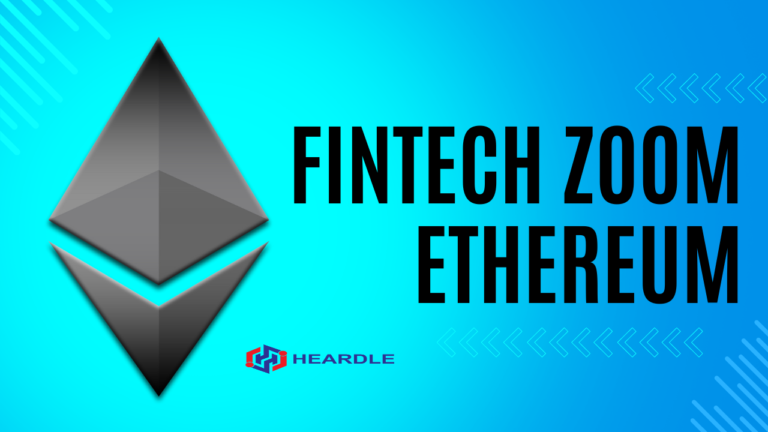presentation
Fintech Zoom Ethereum has become a prominent name in the financial technology space, delivering insights and updates on fintech trends. When paired with Ethereum—a leader in blockchain technology—these two domains unlock transformative possibilities for global finance. This article delves into the intricate relationship between Fintech Zoom and Ethereum, examining how Ethereum’s blockchain technology shapes the fintech sector, why it matters, and its future potential.
Understanding Ethereum and Its Role in Fintech
What is Ethereum?
Ethereum is a decentralized blockchain platform that enables developers to build and deploy smart contracts and decentralized applications (dApps). Created by Vitalik Buterin in 2015, Ethereum introduced a flexible framework that supports programmable transactions and services beyond cryptocurrency, making it a pivotal technology in the financial technology ecosystem.
How Ethereum Differs from Bitcoin
Although both Bitcoin and Ethereum operate on blockchain technology, their purposes are distinct:
Bitcoin is primarily a digital currency for peer-to-peer transactions.
Ethereum serves as a platform for building dApps and smart contracts, offering broader use cases such as decentralized finance (DeFi), tokenization, and supply chain management.
Ethereum’s Relevance in Fintech
Ethereum’s decentralized network provides a foundation for innovation in fintech, disrupting traditional financial systems. With its smart contract functionality, Ethereum facilitates trustless, automated transactions, reducing intermediaries and costs.
Key Features of Ethereum That Drive Fintech Innovation
Smart Contracts
Smart contracts are self-executing agreements with the terms directly written into code. They enable secure and transparent transactions without the need for intermediaries. For fintech, this translates to faster settlements, reduced fraud, and cost-efficiency.
Decentralization
Ethereum operates on a decentralized network, eliminating the need for centralized authorities. This democratizes access to financial services and ensures greater transparency.
Ethereum Virtual Machine (EVM)
The EVM allows developers to build versatile applications on Ethereum’s blockchain. This adaptability makes Ethereum a powerhouse for creating fintech solutions such as payment gateways, lending platforms, and insurance protocols.
Tokenization
Ethereum supports token creation using standards like ERC-20 (fungible tokens) and ERC-721 (non-fungible tokens or NFTs). These tokens are critical for digitizing assets, enabling crowdfunding, and powering loyalty programs in fintech.
Fintech Zoom: Bridging Finance and Technology
What is Fintech Zoom?
Fintech Zoom is an online platform that provides news, insights, and analyses of the financial technology sector. Covering topics like cryptocurrencies, blockchain, and digital banking, Fintech Zoom helps professionals and enthusiasts stay informed about the rapidly evolving fintech landscape.
The Platform’s Role in Ethereum Adoption
Fintech Zoom often highlights Ethereum’s developments, emphasizing its role in transforming global finance. Through articles, expert opinions, and case studies, the platform educates its audience about Ethereum’s potential in revolutionizing payments, lending, and decentralized governance.
Use Cases of Ethereum in Fintech
Decentralized Finance (DeFi)
Ethereum is the backbone of the DeFi movement, enabling peer-to-peer financial services without intermediaries. Popular DeFi applications include:
Lending and Borrowing Platforms: Aave and Compound allow users to lend or borrow assets securely.
Decentralized Exchanges (DEXs): Platforms like Uniswap enable users to trade cryptocurrencies directly.
Yield Farming: Investors earn returns by providing liquidity to DeFi protocols.
Payment Solutions
Ethereum facilitates fast and low-cost cross-border transactions. Startups leverage Ethereum’s blockchain to bypass traditional banking networks, ensuring real-time payment settlements.
Tokenized Assets
From real estate to stocks, Ethereum enables the tokenization of physical and digital assets. These tokens can be traded on blockchain marketplaces, enhancing liquidity and accessibility.
InsurTech
Ethereum powers decentralized insurance models where claims are processed through smart contracts. This reduces fraud, streamlines claims, and enhances customer trust.
Challenges and Criticisms
Scalability Issues
Ethereum’s network has struggled with congestion during periods of high demand, leading to slower transactions and higher gas fees. Ethereum 2.0, with its shift to Proof of Stake (PoS), aims to address these challenges.
Regulatory Concerns
The decentralized nature of Ethereum often clashes with regulatory frameworks, creating uncertainties for fintech companies operating on its platform.
Security Vulnerabilities
While Ethereum’s blockchain is secure, vulnerabilities in smart contract coding can lead to exploits, resulting in significant financial losses.
The Future of Fintech with Ethereum
Ethereum 2.0: A Game-Changer
Ethereum’s transition to Ethereum 2.0 introduces significant upgrades, including:
Proof of Stake (PoS): Enhances energy efficiency and network security.
Sharding: Increases scalability by dividing the blockchain into smaller, manageable parts.
These changes will make Ethereum more robust, enabling it to support even more fintech applications.
Mainstream Adoption
As fintech solutions built on Ethereum become more user-friendly and scalable, mainstream adoption of blockchain-based financial services is inevitable.
Integration with Artificial Intelligence (AI)
The convergence of Ethereum’s blockchain with AI technologies will enable predictive analytics, automated financial advice, and personalized user experiences in fintech.
Conclusion
Ethereum and Fintech Zoom exemplify how blockchain and financial technology are reshaping the world of finance. Ethereum’s innovative features, like smart contracts and decentralization, make it a cornerstone of fintech development, while Fintech Zoom plays a pivotal role in disseminating knowledge and fostering adoption. Together, they illuminate the path toward a more inclusive, efficient, and transparent financial ecosystem.


